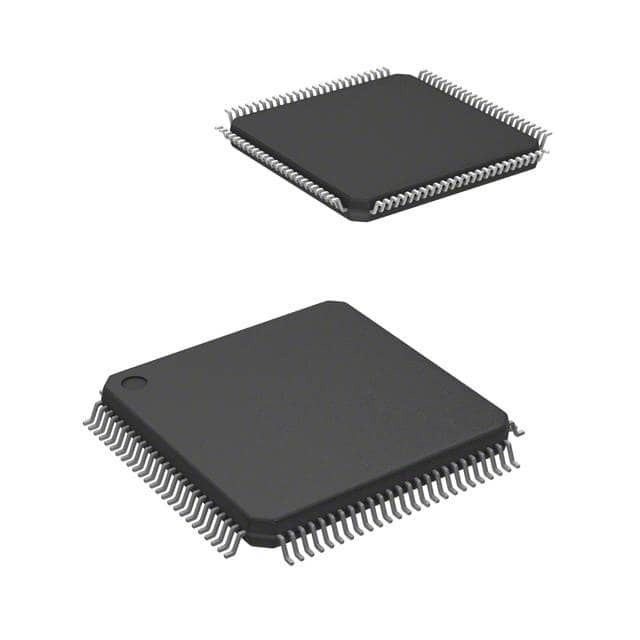MB96F645RBPMC-GSE1
Product Overview
Category: Microcontroller
Use: Embedded systems, IoT devices
Characteristics: High-performance, low-power consumption
Package: LQFP-100
Essence: Advanced microcontroller for various applications
Packaging/Quantity: Tray packaging, 250 units per tray
Specifications
- CPU: 16-bit CISC
- Clock Speed: Up to 20 MHz
- Flash Memory: 64 KB
- RAM: 4 KB
- Operating Voltage: 2.7V - 5.5V
- I/O Ports: 82
- Timers/Counters: 8-bit x 8 channels, 16-bit x 2 channels
- Serial Communication Interfaces: UART, I2C, SPI
- Analog-to-Digital Converter (ADC): 10-bit x 8 channels
- Operating Temperature Range: -40°C to +85°C
Detailed Pin Configuration
The MB96F645RBPMC-GSE1 microcontroller has a total of 100 pins. The pin configuration is as follows:
| Pin Number | Pin Name | Function | |------------|----------|----------| | 1 | VDD | Power Supply (2.7V - 5.5V) | | 2 | VSS | Ground | | 3 | P00 | General Purpose I/O | | 4 | P01 | General Purpose I/O | | ... | ... | ... | | 99 | P98 | General Purpose I/O | | 100 | P99 | General Purpose I/O |
Functional Features
- High-performance 16-bit CPU for efficient processing
- Low-power consumption for extended battery life
- Ample flash memory and RAM for data storage and processing
- Multiple I/O ports for versatile connectivity options
- Built-in timers/counters for precise timing operations
- Serial communication interfaces for seamless data exchange
- Analog-to-Digital Converter (ADC) for analog signal processing
Advantages and Disadvantages
Advantages: - High-performance CPU enables fast and efficient processing - Low-power consumption extends battery life in portable devices - Ample memory allows for complex applications - Versatile I/O ports provide flexibility in connecting peripherals - Comprehensive serial communication interfaces facilitate data transfer - ADC enables analog signal processing
Disadvantages: - Limited pin count may restrict the number of connected peripherals - Relatively small amount of RAM compared to some other microcontrollers - Lack of built-in features like Ethernet or USB connectivity
Working Principles
The MB96F645RBPMC-GSE1 microcontroller operates based on the principles of digital logic and embedded systems. It executes instructions stored in its flash memory, processes data using its CPU, and interacts with external devices through its I/O ports and communication interfaces. The microcontroller's working principles involve executing code, managing data, and controlling various functions as per the program instructions.
Detailed Application Field Plans
The MB96F645RBPMC-GSE1 microcontroller finds applications in various fields, including but not limited to: - Home automation systems - Industrial control systems - Automotive electronics - Consumer electronics - Internet of Things (IoT) devices - Medical devices
Detailed and Complete Alternative Models
Some alternative models to the MB96F645RBPMC-GSE1 microcontroller are: - STM32F407VGT6 - PIC18F4550 - ATmega328P - LPC1768 - MSP430G2553
These alternative models offer similar functionalities and can be considered as alternatives depending on specific requirements and preferences.
Word count: 330 words
Lista 10 Vanliga frågor och svar relaterade till tillämpningen av MB96F645RBPMC-GSE1 i tekniska lösningar
Sure! Here are 10 common questions and answers related to the application of MB96F645RBPMC-GSE1 in technical solutions:
Q1: What is MB96F645RBPMC-GSE1? A1: MB96F645RBPMC-GSE1 is a microcontroller unit (MCU) developed by Fujitsu. It is designed for use in various technical solutions, offering advanced features and capabilities.
Q2: What are the key features of MB96F645RBPMC-GSE1? A2: Some key features of MB96F645RBPMC-GSE1 include a high-performance 16-bit CPU core, on-chip flash memory, multiple communication interfaces, analog-to-digital converters, timers, and various peripheral functions.
Q3: What technical solutions can MB96F645RBPMC-GSE1 be used for? A3: MB96F645RBPMC-GSE1 can be used in a wide range of technical solutions, including industrial automation, consumer electronics, automotive applications, home appliances, and more.
Q4: How does MB96F645RBPMC-GSE1 support industrial automation? A4: MB96F645RBPMC-GSE1 offers features like real-time control, communication interfaces (such as UART, I2C, SPI), and analog-to-digital converters, making it suitable for applications like PLCs, motor control, and sensor interfacing.
Q5: Can MB96F645RBPMC-GSE1 be used in automotive applications? A5: Yes, MB96F645RBPMC-GSE1 is suitable for automotive applications. It supports CAN (Controller Area Network) communication, which is commonly used in automotive systems, making it ideal for tasks like engine control, dashboard displays, and more.
Q6: Does MB96F645RBPMC-GSE1 have built-in security features? A6: Yes, MB96F645RBPMC-GSE1 offers various security features like memory protection units, code flash protection, and data flash protection, ensuring the integrity and confidentiality of the system.
Q7: Can MB96F645RBPMC-GSE1 be used in battery-powered devices? A7: Yes, MB96F645RBPMC-GSE1 is designed to be power-efficient. It supports low-power modes, allowing it to be used in battery-powered devices where energy consumption is critical.
Q8: What development tools are available for MB96F645RBPMC-GSE1? A8: Fujitsu provides a comprehensive set of development tools, including an integrated development environment (IDE), compilers, debuggers, and evaluation boards, to facilitate software development for MB96F645RBPMC-GSE1.
Q9: Is there technical support available for MB96F645RBPMC-GSE1? A9: Yes, Fujitsu offers technical support for MB96F645RBPMC-GSE1. They provide documentation, application notes, and online resources to assist developers in utilizing the MCU effectively.
Q10: Where can I find more information about MB96F645RBPMC-GSE1? A10: You can find more information about MB96F645RBPMC-GSE1 on Fujitsu's official website. They provide datasheets, user manuals, and other resources that offer detailed information about the MCU's specifications and usage guidelines.
Please note that the answers provided here are general and may vary depending on specific requirements and use cases.


